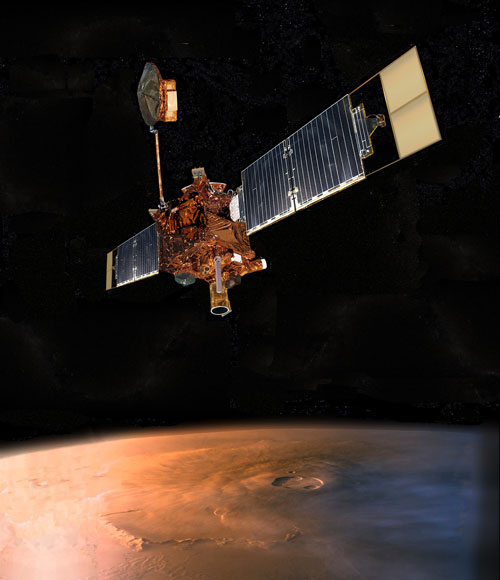NASA's Newest Red Planet Orbiter to Search for Silent Mars Global Surveyor

DENVER, Colorado - Thehunt is on for the still-silent Mars Global Surveyor, the venerable NASA orbiter that failed to phone home earlier this month.
Nowanother Mars orbiter is being primed to image the missing-in-action spacecraft.
NASA will attempt this week to use the Mars Reconnaissance Orbiter to spot the errant Mars Global Surveyor (MGS). Ifsuccessfully identified and photographed, engineers might be able to better assess what's ailing thetroubled probe and perhaps take corrective steps.
Spacecraftengineers remain puzzled as to what occurred onboard the Mars orbiter tocurtail its communications with Earth.
MGSwas last heard from on November 5 after reporting earlier that it had problemswith a solar panel. Since then, repeat tries at regaining contact with MGSusing the Jet Propulsion Laboratory's Deep Space Network of powerful radiodishes were to no avail.
Deep in troubleshooting
Engineershere at Lockheed Martin Space Systems--designer and builder of the long-runningMGS--have been busily studying the situation. Navigation, instrument, andspacecraft teams are deep in troubleshooting what might have happened to theorbiter.
Breaking space news, the latest updates on rocket launches, skywatching events and more!
Withoutradio contact the true whereabouts of MGS isn't precisely known.
"Rightnow we don't have a great estimate on exactly where MGS is since it has beenout of contact for a while," said Wayne Sidney, the Mars Reconnaissance OrbiterFlight Engineering Team Lead for Lockheed Martin Space Systems.
MGScould be in a self-generated safe mode, perhaps making use of its thrusters andhas perturbed its orbit about Mars, Sidney told SPACE.com. Byextrapolating from the last known position of MGS, experts hope to deduce thecoordinates for where the craft should be as it spins around Mars.
Two-step plan
Taskingthe Mars Reconnaissance Orbiter (MRO) which was also designed and built byLockheed Martin Space Systems, to image MGS won't be easy. Sidney said thatthere's a plus or minus 45 second window of error to deal with in catching sightof MGS.
Atwo-step plan is being implemented, Sidney advised. The strategy calls forutilizing MRO's High Resolution Imaging Science Experiment (HiRISE) camera onWednesday, Sidney said, to take a long-exposure that, it is hoped, grabs aglimpse of the MGS.
Giventhat HiRISE successfully picks up the fast-moving MGS, then more precise andhigher-resolution targeting of the camera system can be done on Friday, Sidney said.
"Soit's two steps...back to back," Sidney noted. "It has been a scramble to try andfigure out how to do it. It's going to take a lot of push ups to get it donethis week, but I think everybody involved is actually pretty excited about it.Most of us worked both [MGS and MRO] programs."
PhotographingMGS would help mission controllers learn what direction the spacecraft'smast-mounted, high-gain antenna is pointed. It is used to receive signals fromEarth as well as send transmissions to ground controllers. Also, knowing theorientation of the spacecraft's solar panels would be a plus, Sydney said.
Lost cause?
Asfor calling MGS a lost cause, Sidney stated that there could definitely be ascenario that brings the mute of a probe back to life. But MGS is the oldest ofsix spacecraft now active at the red planet and has been in service longer thanany other spacecraft ever sent to Mars.
Launchedin November 1996, the MGS original mission was to examine Mars for a fullMartian year, roughly two Earth years. Once that period elapsed, NASA extendedthe mission repeatedly, most recently on October 1 of this year.
It'simportant to recognize that MGS was on its third extended mission, Sidney said. And through all the years of scanning Mars, he added, MGS also supported theMars Reconnaissance Orbiter's lengthy aerobraking at the planet by watching formartian dust storms that influence Mars' upper atmosphere.
There'sa feeling that maybe the well-used MGS felt it was time to sign off.
Onthe 10th anniversary of MGS in space--November 7--that's the same day that MROcranked up its primary science tasks.
"Itreally seems like there's some fate involved in this," Sidney said. "MGS knewit was time to retire."
- Get to Know MRO
- Images: Mars Express: A Year of Discoveries
- NASA Compiles 25,000-Picture Atlas of Mars
- Mars Global Surveyor Stars in New Role
- The 10 Best Mars Images Ever

Leonard David is an award-winning space journalist who has been reporting on space activities for more than 50 years. Currently writing as Space.com's Space Insider Columnist among his other projects, Leonard has authored numerous books on space exploration, Mars missions and more, with his latest being "Moon Rush: The New Space Race" published in 2019 by National Geographic. He also wrote "Mars: Our Future on the Red Planet" released in 2016 by National Geographic. Leonard has served as a correspondent for SpaceNews, Scientific American and Aerospace America for the AIAA. He has received many awards, including the first Ordway Award for Sustained Excellence in Spaceflight History in 2015 at the AAS Wernher von Braun Memorial Symposium. You can find out Leonard's latest project at his website and on Twitter.
